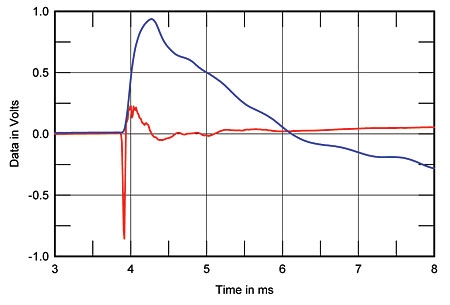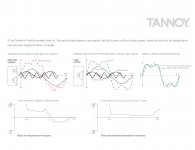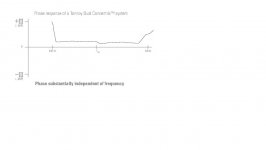From the measurements I did on my Tannoy System 800s, their time alignment seems worse than a traditional 2-way box speaker, at least on-axis. The acoustic centre of the HF driver is about 2 inches behind the LF one giving a considerable time delay.
KEF's Uni-Q driver has better time alignment, as they stuck the tweeter on the end of the woofer pole piece.
KEF's Uni-Q driver has better time alignment, as they stuck the tweeter on the end of the woofer pole piece.
From the measurements I did on my Tannoy System 800s, their time alignment seems worse than a traditional 2-way box speaker, at least on-axis.
The acoustic centre of the HF driver is about 2 inches behind the LF one giving a considerable time delay.
KEF's Uni-Q driver has better time alignment, as they stuck the tweeter on the end of the woofer pole piece
Hi and thanks for the helpful explanation.
Time alignment is the same as phase response ?
Sorry but i am quite ignorant.
The time alignment i can understand more easily. It is the delay between the drivers. The signal coming from one driver reaches the listener at a different time of the signal coming from the other driver ... this is fine.
Phase response is a very difficult concept for me to understand.
And also i do not know if it impacts sound quality.
But as i have big respect for Tannoy brand, if they show this very good phase response of their speakers i think it must be worth something.
Thanks again, gino
Is it true that Tannoy coaxials give a such good phase response ?
These are conceptual drawings, not measurements. It just shows the time delay on a tweeter is reduced by mounting it coaxially.
Also they are mistaken, you want LINEAR phase, which can be a line with a slope, not constant phase.
Linear phase is equivalent to a constant time delay.
Last edited:
These are conceptual drawings, not measurements. It just shows the time delay on a tweeter is reduced by mounting it coaxially.
Hi and thanks for the replay
I reload the image just to focus better the question
I am mostly interested in the phase response not time alignment
unless they are the same thing of course ... i do not know
Thanks a lot, gino
Attachments
These are conceptual drawings, not measurements. It just shows the time delay on a tweeter is reduced by mounting it coaxially.
Also they are mistaken, you want LINEAR phase, which can be a line with a slope, not constant phase.
Linear phase is equivalent to a constant time delay.
Hi and thanks a lot for the explanation
I give up. If they make such mistakes even on official brochure it is too confusing for me. I am surprised by the way, in a bad way.
Thanks again, gino
Time alignment and phase response are not the same thing but they are closely related.
I think the phase response of a dual concentric driver must be pretty bad unless the crossover was specially designed to straighten it out. Tannoy don't do this, they use quite simple crossovers.
There is no proof that phase is audible, but that doesn't stop many speaker designers believing that linear phase response through the midrange makes a speaker sound better.
I think the phase response of a dual concentric driver must be pretty bad unless the crossover was specially designed to straighten it out. Tannoy don't do this, they use quite simple crossovers.
There is no proof that phase is audible, but that doesn't stop many speaker designers believing that linear phase response through the midrange makes a speaker sound better.
I am mostly interested in the phase response not time alignment unless they are the same thing of course.
Well, the phase response and time delay are not the same, but they are related. A pure time delay causes a linear phase shift as seen on a graph.
Other aspects of a system can cause other phase shifts, and they add to the pure time delay. Of course, if the drivers are not mounted in a coaxial fashion, the pure time delay will change depending on which driver is operating. This is why coaxial mounting is done, to reduce this problem.
The old DC Tannoy arranged that the phase response from the crossover and the drivers were such that at the crossover frequency the treble was ~3" earlier than the bass.
That ~3" is the distance that the effect source of the treble is behind the effective source of the bass.
i.e. at crossover the two signals are in phase.
I don't know what happened when they changed to the ferrite magnet system.
That ~3" is the distance that the effect source of the treble is behind the effective source of the bass.
i.e. at crossover the two signals are in phase.
I don't know what happened when they changed to the ferrite magnet system.
phase error around the crossover frequency is audible....................There is no proof that phase is audible,............
It's why we get a lobe pointing down to the floor for a "simple" crossover.
LR arranges for the lobe to point forward by getting the phase at crossover correct.
When the drivers' outputs are "in phase" we are left with ensuring that the sources are the same distance from the listener.
There is no proof that phase is audible, but that doesn't stop many speaker designers believing that linear phase response through the midrange makes a speaker sound better.
If a phono cartridge, an amplifier, etc. had phase response like most speakers, people would call them garbage.
Excusing gross errors because it's hard to improve them is not the way to progress.
Time alignment and phase response are not the same thing but they are closely related.
I think the phase response of a dual concentric driver must be pretty bad unless the crossover was specially designed to straighten it out.
Tannoy don't do this, they use quite simple crossovers.
There is no proof that phase is audible, but that doesn't stop many speaker designers believing that linear phase response through the midrange makes a speaker sound better.
Hi and thanks again
This phase is my nightmare
For instance i have seen 2 ways speaker in which woofer and tweeter are wired in opposition of phase
Then looking at the time alignment graph if they were wired in the opposite way the time alignment would be perfect
One case taken from the Stereophile magazine
Lipinski Sound L-707 loudspeaker Measurements | Stereophile.com
and the graph from which you can see that the tweeter is connected in inverted acoustic polarity to the woofers

why this choice i do not understand.
If the tweeter would have been connected with the same polarity of the woofers the time response would have been almost perfect.
The alignment is obtained with the tweeter mounted behind the plane of woofers (a very good design choice i understand).
By the way while i see often time alignment measurements i have almost never seen phase response graph before.
The fact that the graph is wrong puzzles me profoundly.
Very deeply. I trusted Tannoy.
Thanks again, gino
phase error around the crossover frequency is audible.
It's why we get a lobe pointing down to the floor for a "simple" crossover.
In this case, phase error is only audible because it leads to amplitude errors in the off-axis frequency response and the room adds this to the on-axis response at the listening position.
You are not hearing phase, you are hearing amplitude changes that would be hidden if you were sitting 1m away on-axis in an anechoic chamber. Of course nobody listens to speakers like this so the question is somewhat academic.
Dual concentric drivers have lobing and beaming issues too, the only difference is that the pattern is constrained to have circular symmetry. (Imagine the pattern of the D'Appolito array, then go from 2 woofers to a ring of woofers around the tweeter.)
Well, the phase response and time delay are not the same, but they are related.
A pure time delay causes a linear phase shift as seen on a graph.
Other aspects of a system can cause other phase shifts, and they add to the pure time delay. Of course, if the drivers are not mounted in a coaxial fashion, the pure time delay will change depending on which driver is operating.
This is why coaxial mounting is done, to reduce this problem.
Hi and thanks again sincerely
so this brochure is just marketing bull...t

Not a nice service to the customer indeed
I will study more about this phase issue ... it is intriguing
Thanks again, gino
The old DC Tannoy arranged that the phase response from the crossover and the drivers were such that at the crossover frequency the treble was ~3" earlier than the bass.
That ~3" is the distance that the effect source of the treble is behind the effective source of the bass.
i.e. at crossover the two signals are in phase.
I don't know what happened when they changed to the ferrite magnet system.
Hi and this is very interesting
You mean that the bass was delayed of ~3" ?
How can this be done passively ?
Thanks a lot, gino
Alnico powered (at least) Tannoy DC's had tweeters in reverse phase.
Works Exceptionally well.
KEF Uniques were a cheap bodge setup that simply didn't work well enough to justify their existence.
NO idea how a Definition series Tannoy Does or Doesn't work.
Nor do I care to find out
Works Exceptionally well.
KEF Uniques were a cheap bodge setup that simply didn't work well enough to justify their existence.
NO idea how a Definition series Tannoy Does or Doesn't work.
Nor do I care to find out
Lipinski Sound L-707 loudspeaker Measurements | Stereophile.com
and the graph from which you can see that the tweeter is connected in inverted acoustic polarity to the woofers

why this choice i do not understand.
I believe this choice is actually quite common and technically correct. Look at the measured step response of the Vivid G1 Giya speaker here. Vivid Audio G1Giya loudspeaker Measurements | Stereophile.com
The idea is not for all the drivers in a multi-way loudspeaker to rise together. They can't because the rise times are so different. The best you can do is that the decay of each drive unit should match the rise time of the next bigger one. If you pull this off perfectly, the impulse response becomes a Chirp - Wikipedia, the free encyclopedia and you get a flat frequency response by definition, as the chirp is just an impulse with its phase dispersed.
I believe this choice is actually quite common and technically correct. Look at the measured step response of the Vivid G1 Giya speaker here. Vivid Audio G1Giya loudspeaker Measurements | Stereophile.com
Hi and sorry but in the case you mention
like i think they should.All the drivers appear to be connected in positive acoustic polarity
The idea is not for all the drivers in a multi-way loudspeaker to rise together. They can't because the rise times are so different.
Actually i thought the exact opposite, that the idea is really to have all the drivers response peaks " more or less" aligned, like in a single wideband driver for instance.
This could be realized or with some kind of delaying circuits (active or passive) or placing the drivers on different planes, like for instance in the B&W approach with the mid and tweeter mounted recessed in respect to the woofer.
The same could have been done here with a better placement of the drivers.
The distance between planes can be calculate multiplying the sound speed for the delay time in ms.
The question about of much delay can be actually heard is open to debate.
Someone says that delays up to 4 ms are not perceived by the ear.
For me it is nice to have everyhting aligned ... like when you focus with a camera.
The best you can do is that the decay of each drive unit should match the rise time of the next bigger one.
If you pull this off perfectly, the impulse response becomes a Chirp - Wikipedia, the free encyclopedia and you get a flat frequency response by definition, as the chirp is just an impulse with its phase dispersed
Interesting. I did not know this.
I have to say that i like the coaxial concept a lot indeed and you know when i like something even on an irrational basis i start to be intrigued by it.
My ideal coaxial would be a very big pro one ... one of those huge coaxial for big venues.
Then x-over and eq digitally executed ... from 40 to 16kHz ...
High level and low distortion.
This is a very long term project by the way.
Thanks a lot again, gino
Last edited:
Alnico powered (at least) Tannoy DC's had tweeters in reverse phase. Works Exceptionally well.
Hi and thanks. Very interesting to know.
Maybe they would work just as well without phase reversing ... but ok i have not any clue about this at all of course.
Nevertheless i will try to find some papers on this very interesting issue.
KEF Uniques were a cheap bodge setup that simply didn't work well enough to justify their existence.
I know that also Kef is active on coaxial ... but the classic ones come from Tannoy and Altec ... i would prefer these brands.
They have built their fame on them.
NO idea how a Definition series Tannoy Does or Doesn't work.
Nor do I care to find out
What has triggered my interest is an offer about a 2nd hand but in extremely good condition pair of Tannoy Precision 8P
http://resolution.nodecube.net/products/pdfs/Monitoring/Tannoy%20Precision%208P.pdf
the owner wants something like 308.542CAD ...
I cannot buy 2 good woofers for the same price.
So this is why all these questions ...
Thanks a lot again. Kind regards, gino
P.S. i am completely forced to listen in the nearfield ( ~ 2 meters) at present ... so the coaxial concept could be optimal for this purpose.
Last edited:
What has triggered my interest is an offer about a 2nd hand but in extremely good condition pair of Tannoy Precision 8P
Well, first of all for $300 I would buy them. A lot of speaker for the money.
I had a lot of issues with my System 800s, which I documented here http://www.diyaudio.com/forums/multi-way/265772-tannoy-system-800-never-sounded-right.html but the Precision 8P seems to be a quite different design with the drivers much better integrated. The measurement results given here http://resolution.nodecube.net/products/pdfs/Monitoring/Tannoy Precision 8P.pdf are much better than I observed for the System 800s.
Then again, the measurements published in the System 800 manual are also much better than what I actually got, which might make you doubt Tannoy's quality control.
I also have a pair of KEF LS50s and these blow the System 800s out of the water. I don't think the Uni-Q system is a bodge at all, it is just a different design approach. The Tannoy dual concentric is a classical horn with constant directivity, the Uni-Q is a short conical waveguide with wide dispersion (and better time alignment)
This is the time-aligned school of speaker design that aims to reassemble a perfect impulse at the listener's ear. I showed the measurements of the G1 Giya because it is something quite different to time-aligned and yet it works out the same. If they had plotted its phase response, it would still be a nice smooth line, it just wouldn't be horizontal. They have allowed the phase to disperse linearly, to make other aspects of the design easier.Actually i thought the exact opposite, that the idea is really to have all the drivers response peaks " more or less" aligned, like in a single wideband driver for instance
What matters in this school of speaker design is for the decay of each drive unit to match the rise of the next, as you are trying to assemble a chirp out of a bunch of wibbles. Depending on the crossover order, the initial rise could have the same polarity as the decay, or the opposite.
Last edited:
- Status
- This old topic is closed. If you want to reopen this topic, contact a moderator using the "Report Post" button.
- Home
- Loudspeakers
- Multi-Way
- Tannoy DC and phase response.

